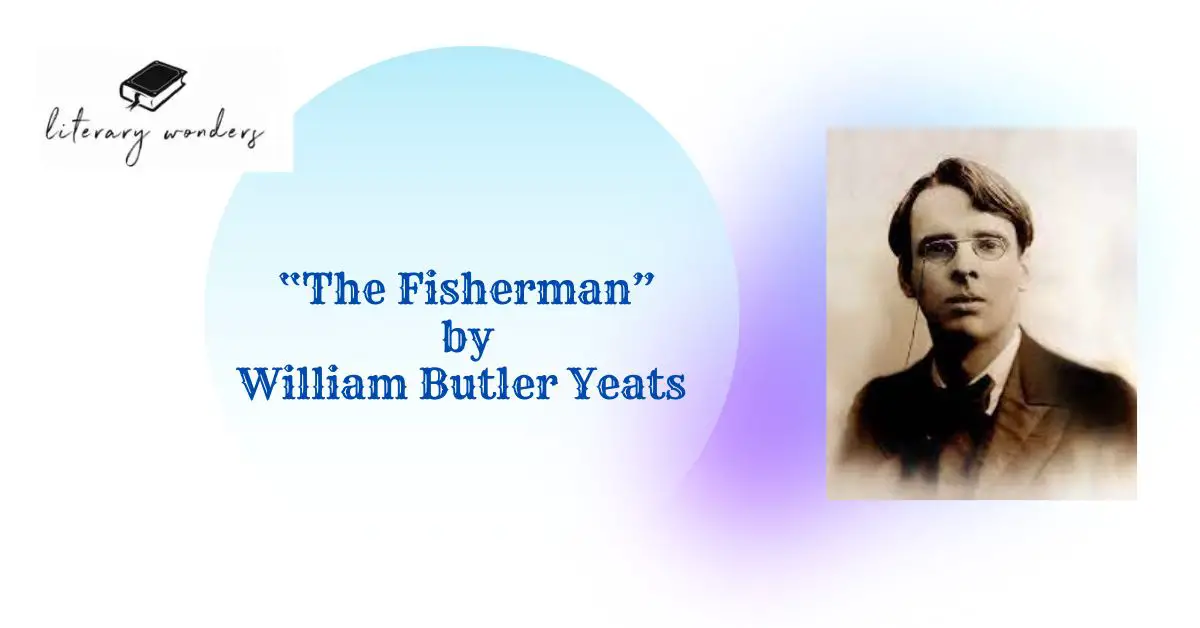“The Fisherman” by William Butler Yeats Analysis
Introduction
- Published in 1919 in The Wild Swans ay Coole, “The Fisherman” is a nature poem. William Butler Yeats, a phenomenal writer, and poet, tries to show his love for nature and genuine art in this poem. He talks about the beautiful art that contains beauty and truth. The poem became popular because it stresses the life of an ordinary man.
Summary of The Poem, “The Fisherman”
- The poem presents the writer’s contrasting thoughts regarding the everyday world. He begins the poem by recounting a professional fisherman that he once met. He kept a close eye on his life and respected his straightforward demeanor. The fisherman is of his race, which is uncommon in today’s world, and this is why he was drawn to him. The fisherman appears to live up to the speaker’s high standards. As the poem continues, the speaker rails against contemporary Irish men, saying they fall short of the speaker’s amorous ideals. Also, he addresses the apathetic attitude of modern man before returning to the subject of the fisherman once again toward the end of the poem. According to him, individuals such as fishermen only exist in poetic dreams and not in the actual world.
Major Themes In “The Fisherman”
- The poem’s main themes are beauty, the ideal man against modern man, and man against nature. Yeats depicts the perfect man in this poem by using a contrastive technique. He believes that ideal people remain in touch with nature and their roots. Because the speaker has observed the fisherman closely and believes that he is a real person, the fisherman is presented by the speaker as the embodiment of perfection. The writer beautifully reflects his perception of the simplicity, peace, and unity among the Irish people of his era in the image of the fisherman. But the contemporary Irish man lacks these attributes. In order to serve as a reminder that despite how advanced contemporary man has gotten, the poet depicts a nature-loving fisherman.
- To Read the Full Poem Please Click Here.
Poetic Elements Used in “The Fisherman”
William Butler Yeats has enhanced the intended effects of his poem by utilizing a number of poetic elements. Some of the poetic elements used in the poem are as follows.
- Assonance: When vowel sounds are repeated in a line, it is known as assonance. Examples of this include the sounds of /e/ in “Aimed at the commonest ear” and /o/ in “To write for my own race.”
- Alliteration: The second technique is alliteration, which is the rapid sequence of consonant sounds repeated in the same line. Examples of this are the sounds /h/ in “What I had hoped it would be” and /k/ in “The catch cries of the clown.”
- Anaphora: Anaphora is the term used to describe how certain verses repeat a word or phrase in the opening section. In the poem’s final stanza, Yeats uses the word “A man” twice to highlight certain points, like;
“A man who does not exist,
A man who is but a dream”
- Allusion: An indirect connection to a person, place, object, or idea with historical, cultural, political, or literary significance is a belief in allusion. The poet’s conception of the ideal man in his day is alluded to in the lines that follow.
“A man who does not exist,
A man who is but a dream;”
- Consonance: The repeating of consonant sounds inside a single line, as the sound of /t/ in “The beating down of the wise” and the sound of /h/ in “What I had hoped it would be.”.
- Diction: Diction refers to the kind of language. The poem uses poetic, straightforward, and detailed language.
- End Rhyme: The stanza gains melody with the usage of End Rhyme. In this poem, William Butler Yeats employs end rhymes such “face/race,” “still/hill,” and “flies/eyes.”
- Enjambment: Enjambment is the poetic device when a notion flows from one line to the next without stopping at the finish.
“At dawn to cast his flies—
It’s long since I began
To call up to the eyes
This wise and simple man.”
- Imagery: Readers are made to perceive things through their five senses through the use of imagery. “I shall have written him one,” “When the flies drop in the stream,” and “And his sun-freckled face” are examples of the imagery employed by William Butler Yeats.
- Metaphor: This is a figure of speech in which two objects with differing natures are impliedly compared. The poet illustrates how man has transformed himself by contemporary standards of living by employing the extended metaphor of change.
- Symbolism: Symbolism refers to the application of symbols to represent concepts and attributes, endowing them with meanings that deviate from their literal interpretations. The poem uses symbols like options, an ideal world, and the contemporary way of looking at the world and complaining.
- Stanza: A stanza is a group of lines expressed poetically. This poem is divided into two stanzas, each with a separate set of lines.
- Tone: Tone refers to the text’s voice. The poem has a solemn tone at first, but it soon becomes depressing and whiny.
A closer look into literary analysis shows that the poet has expertly concealed his beliefs about the perfect man behind these literary tactics. This poetry is distinctive, captivating, and profound due to the skilful application of various devices.
Suggested Readings

